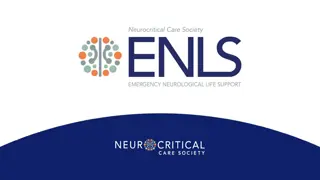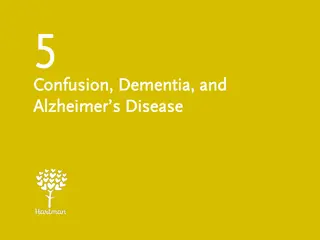Understanding Thrombolytic Therapy in Healthcare
Thrombolytic therapy is a vital treatment aimed at dissolving dangerous blood clots, enhancing blood flow, and preventing tissue damage. This comprehensive guide covers the definition, purposes, indications, contraindications, and nursing management of thrombolytic therapy, providing essential insights for healthcare professionals.
Download Presentation
Please find below an Image/Link to download the presentation.
The content on the website is provided AS IS for your information and personal use only. It may not be sold, licensed, or shared on other websites without obtaining consent from the author. Download presentation by click this link. If you encounter any issues during the download, it is possible that the publisher has removed the file from their server.
Presentation Transcript
THROMBOLYTIC THERAPY Daisy.M.V.(Sr.Daisy Maria) Lecturer JMCON
SPECIFIC OBJECTIVES Define thrombolytic therapy List down the purposes of thrombolytic therapy Discuss the indications and contraindications of thrombolytic therapy Enlist the agents used for thrombolytic therapy Explain the nursing management of thrombolytic therapy
DEFINITION Thrombolytic therapy, is a treatment to dissolve dangerous clots in blood vessels, improve blood flow, and prevent damage to tissues and organs
Cont. Thrombolytics are medications that are usually administered intravenously, although some may also be given directly into the coronary artery in the cardiac catheterization laboratory
PURPOSE Dissolve and lyse the thrombus in a coronary artery (thrombolysis) Allowing blood to flow through the coronary artery again (reperfusion) Minimizing the size of the infarction Preserving ventricular function.
INDICATIONS Chest pain for longer than 20 minutes, unrelieved by nitroglycerin ST-segment elevation in at least two leads that face the same area of the heart Less than 24 hours from onset of pain
CONTRAINDICATIONS Absolute Contraindications Active bleeding Known bleeding disorder History of hemorrhagic stroke History of intracranial vessel malformation Recent major surgery or trauma Uncontrolled hypertension Pregnancy
Cont. RELATIVE CONTRAINDICATIONS Severe, uncontrolled hypertension on presentation (blood pressure >180/110 mm Hg) History of prior cerebrovascular accident or known intracerebral lesion Current use of anticoagulants
Cont. Recent trauma (within 2 4 weeks), including head trauma or traumatic or prolonged (>10 minutes) cardiopulmonary resuscitation or major surgery (<3 weeks) Noncompressible vascular punctures Recent (within 2 4 weeks) internal bleeding
Cont. Pregnancy Active peptic ulcer History of chronic severe hypertension
THROMBOLYTIC AGENTS Thrombolytic agents can be divided into two major categories: fibrin selective & nonselective
Cont. Fibrin-selective agents include: Tissue-type plasminogen activator (t-pa) Recombinant tissue plasminogen activator (alteplase [generic] activase; rt-pa) Recombinant plasminogen activator (reteplase; r-pa) Single-chain urokinase plasminogen activator
Cont. Nonselective agents include: Streptokinase (SK) Anisoylated plasminogen streptokinase activator complex (APSAC) Urokinase
Cont. Streptokinase increases the amount of plasminogen activator, which then increases the amount of circulating and clot-bound plasmin.
Cont. Because streptokinase is made from a bacterium, its use also entails a risk of an allergic reaction. Vasculitis has occurred up to 9 days after administration.
Cont. Streptokinase is not used if the patient has been exposed to a recent Streptococcus infection or has received streptokinase in the past 6 to 12 months.
Cont. Alteplase is a type of tissue plasminogen activator (t-PA). In contrast to streptokinase, alteplase activates the plasminogen on the clot more than the circulating plasminogen.
Cont. Because it does not decrease the clotting factors as much as streptokinase, unfractionated or low molecular weight heparin is used with t-PA to prevent another clot from forming at the same lesion site.
Cont. Because t-PA is a naturally occurring enzyme, allergic reactions are minimized, but t-PA costs considerably more than streptokinase.
Cont. To be effective, thrombolytics must be administered as early as possible after the onset of symptoms that indicate an acute MI. They are not given to patients with unstable angina.
Cont. Hospitals monitor their ability to administer these medications within 30 minutes from the time the patient arrives in the emergency department. This is called door-to-needle time
HOW TO PREPARE 1.Slowly add 5 mL Sodium Chloride Injection or 5% Dextrose Injection to the Streptokinase vial, directing the diluent at the side of the vacuum- packed vial rather than into the drug powder. 2.Roll and tilt the vial gently to reconstitute. Avoid shaking. (Shaking may cause foaming.)
Cont.. 3.Withdraw the entire reconstituted contents of the vial; slowly and carefully dilute further to a total volume of 100 mL. Avoid shaking and agitation on dilution.
Cont. 4.Because Streptokinase, contains no preservatives, it should be reconstituted immediately before use. The solution may be used for direct intravenous administration within eight hours following reconstitution if stored at 2-8 C.
Cont. 5.Do not add other medication to the container of Streptase, Streptokinase. 6.Unused reconstituted drug should be discarded.
PATIENT OUTCOME Bleeding is the most serious complication Hemorrhagic stroke occurred in approximately 0.4%. Reocclusion is a risk and occurs in approximately 12% to 29% of patients
NURSING CONSIDERATIONS Minimize the number of times the patient s skin is punctured. Avoid intramuscular injections. Draw blood for laboratory tests when starting the IV line.
Cont. Start IV lines before thrombolytic therapy; designate one line to use for blood draws. Avoid continual use of noninvasive blood pressure cuff. Monitor for acute dysrhythmias, hypotension, and allergic reaction.
Cont. Monitor for reperfusion: resolution of angina or acute ST-segment changes. Check for signs and symptoms of bleeding: decrease in hematocrit hemoglobin values, decrease in blood pressure, increase in heart rate, oozing or bulging at invasive procedure sites, back pain, muscle weakness, changes in level of consciousness, complaints of headache
Cont. Treat major bleeding by discontinuing thrombolytic therapy and any anticoagulants; apply direct pressure and notify the physician immediately. Treat minor bleeding by applying direct pressure if accessible and appropriate; to monitor.
PREINFUSION CARE Obtain nursing history, and perform a physical assessment. Information obtained from the history and physical exam helps determine whether thrombolytic therapy is appropriate. The goal is to initiate thrombolytic therapy within 30 minutes of arrival.
Cont. Evaluate for contraindications to thrombolytic therapy: recent surgery or trauma (including prolonged CPR), bleeding disorders or active bleeding, cerebral vascular accident, neurosurgery within the last 2 months, gastrointestinal ulcers, diabetic hemorrhagic retinopathy, and uncontrolled hypertension.
Cont. Inform the client of the purpose of the therapy. Discuss the risk of bleeding and the need to keep the extremity immobile during and after the infusion. Minimal movement of the extremity is necessary to prevent bleeding from the infusion site.
DURING THE INFUSION Assess and record vital signs and the infusion site for hematoma or bleeding every 15 minutes for the first hour, every 30 minutes for the next 2 hours, and then hourly until the intravenous catheter is discontinued.
Cont. Assess pulses, color, sensation, and temperature of both extremities with each vital sign check. Vital signs and the site are frequently assessed to detect possible complications.
Cont. Remind the client to keep the extremity still and straight. Do not elevate head of bed above 15 degrees. Extremity immobilization helps prevent infusion site trauma and bleeding. Hypotension may develop keeping the bed flat helps maintain cerebral perfusion.
Cont. Maintain continuous cardiac monitoring during the infusion. Keep antidysrhythmic drugs and the emergency cart readily available for treatment of significant dysrhythmias.
Cont. Ventricular dysrhythmias commonly occur with reperfusion of the ischemic myocardium.
POSTINFUSION CARE Assess vital signs, distal pulses, and infusion site frequently as needed. The client remains at high risk for bleeding following thrombolytic therapy.
Cont. Evaluate response to therapy: normalization of ST segment, relief of chest pain, reperfusion dysrhythmias, early peaking of the CK and CK-MB band. These are signs that the clot has been dissolved and the myocardium is being reperfused.
Cont. Maintain bed rest for 6 hours. Keep the head of the bed at or below 15 degrees. Reinforce the need to keep the extremity straight and immobile. Avoid any injections for 24 hours after catheter removal.
Cont. Assess puncture sites for bleeding. On catheter removal hold direct pressure over the site for at least 30 minutes. Apply a pressure dressing to any venous or arterial sites as needed. Perform routine care in a gentle manner to avoid bruising or injury.
Cont. therapy Thrombolytic disrupts normal coagulation. Peripheral bleeding may occur at puncture sites, and there may not be sufficient fibrin to form a clot. Direct or indirect pressure may be needed to control the bleeding.
REFERENCE Woods SL, Bridges EJ. Cardiac nursing. Sixth edition. Phialadephia: Lippincot Williams and wilkins puplications. Black JM. Medical surgical nursing clinical management for positive outcomes. Seventh edition. Newdelhi : Elsevier publications. Volume2. Chintamani. Lewi s Medical- surgical Nursing. First edition. Haryana: Elsevier publications.

















































